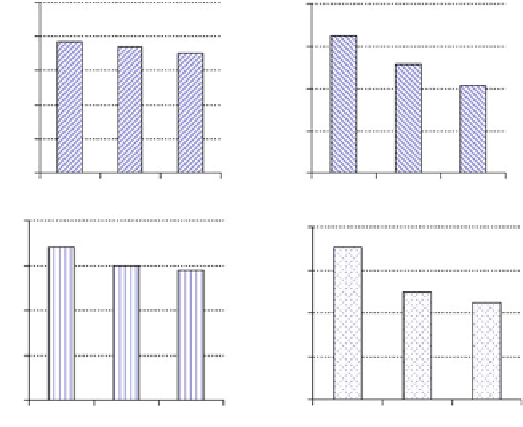Agriculture Reference
In-Depth Information
0.1
20
0.08
15
0.06
10
0.04
5
0.02
0
0
T1
T7
T9
T1
T7
T9
0.4
20
0.3
15
0.2
10
0.1
5
0
0
T1
T7
T9
T1
T7
T9
Fig. 7.1
Nutrient retention in soil at harvest of wheat crop under no irrigation (T1), two irrigation
facilitates quick percolation of water and, thus, greater chance of transport of
solutes.
(h)
Crop rotation
: Crop rotation may influence the uptake, decomposition, and/or
addition of nitrogen in soil and, thus, on the leaching of nitrate.
(i)
Irrigation or rainfall
: In dryland agriculture, the increase in soil moisture that
results from irrigation or rainfall dissolves excess nitrate (NO
3
-N) present in
the soil profile, and makes it more susceptible to leaching. Higher moisture con-
tents will also raise microbial activity including mineralization. The increase in
mineralization rate directly affects nutrient leaching. The initiation of irrigation
caused a flash of NO
3
-N to the shallow groundwater.
(j)
Management factors
: Management factors such as tillage number, mulching,
application of herbicide, etc. influence on the decomposition and mobility of
organic and inorganic nitrogen downwards. A more intensive tillage practice
under irrigated agriculture could increase the mineralization rate. Increased
mineralization rates contribute to the elevated NO
3
-N concentrations in the
subsurface water.
Once released into the subsurface environment, industrial and agricultural chem-
icals are generally subjected to a large number of simultaneous physical, chemical,
and biological processes, including sorption-desorption, volatilization, photolysis,
and biodegradation, as well as their kinetics. The extent of degradation, sorption,
and volatilization largely determines the persistence of a pollutant in the subsur-
face. The fate of organic chemicals in soils is known to be strongly affected by the
kinetics of biological degradation.

Search WWH ::

Custom Search